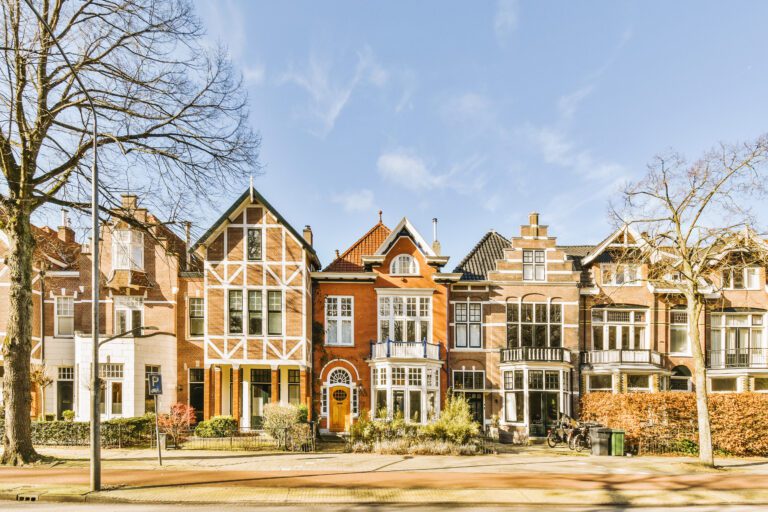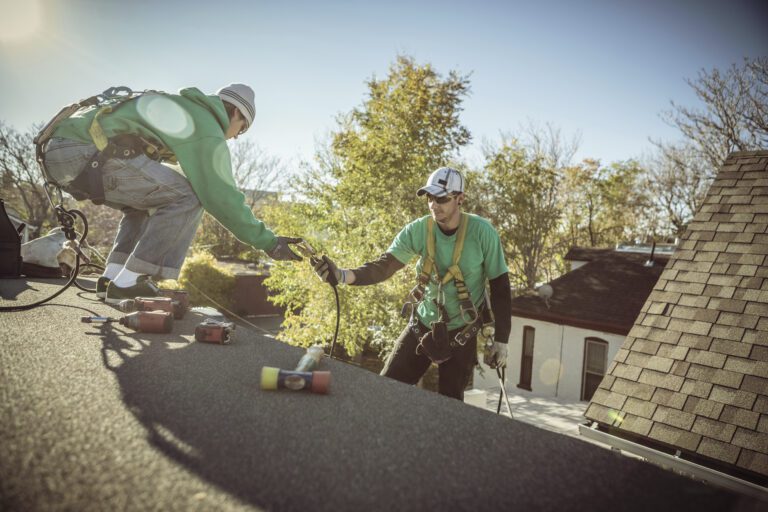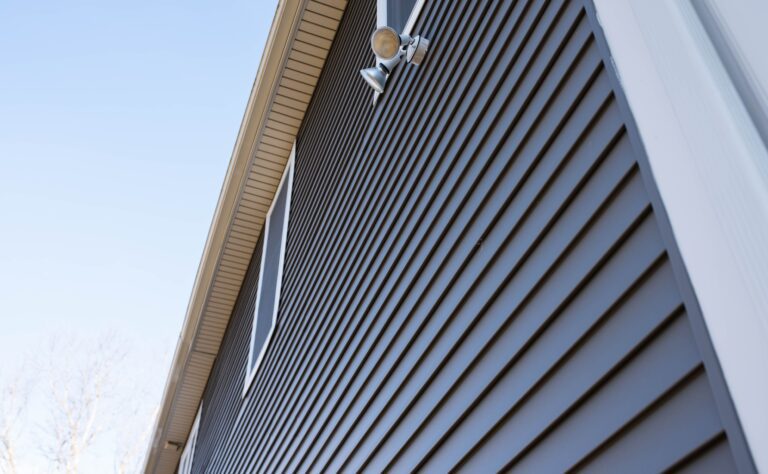Your roof color isn’t just about aesthetics—it affects energy efficiency, curb appeal, and even home value. This guide breaks down the best roof color options and how they impact your home.
- Black Shingles – Timeless, elegant, and now more energy-efficient with reflective granules.
- Brown Shingles – Warm, inviting, and pairs well with natural and earthy exteriors.
- Gray Shingles – A versatile neutral that complements modern and classic home designs.
- Red, Blue & Green Roofs – Bold, stylish, and great for unique architectural styles.
- Cool Roofs & New Trends – Energy-efficient, reflective materials that reduce heat absorption.
Looking to visualize how different roof colors would look on your home? Try Renoworks’ AI-powered exterior design tool to explore options in seconds!
Introduction
Ever wondered how a splash of color could transform not just your home’s curb appeal but also its energy efficiency? Imagine driving through a neighborhood where each house flaunts roofs in shades of vibrant red, calming blue, or even sleek black. It’s like walking into an artist’s palette come to life.
Colored roofs aren’t just about aesthetics; they’re game-changers when it comes to sustainability and comfort. Picture this: on a scorching summer day, your vividly hued roof reflects sunlight instead of absorbing it, keeping the interiors cooler without cranking up the AC. Intrigued yet? Dive deeper with me as we explore how colored roofing can revolutionize both style and functionality for modern homes.
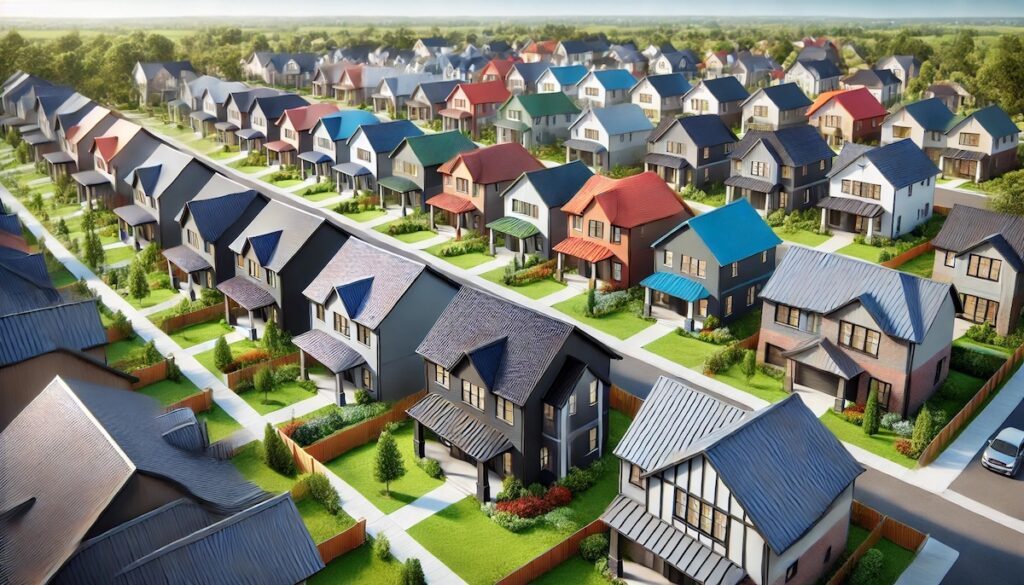
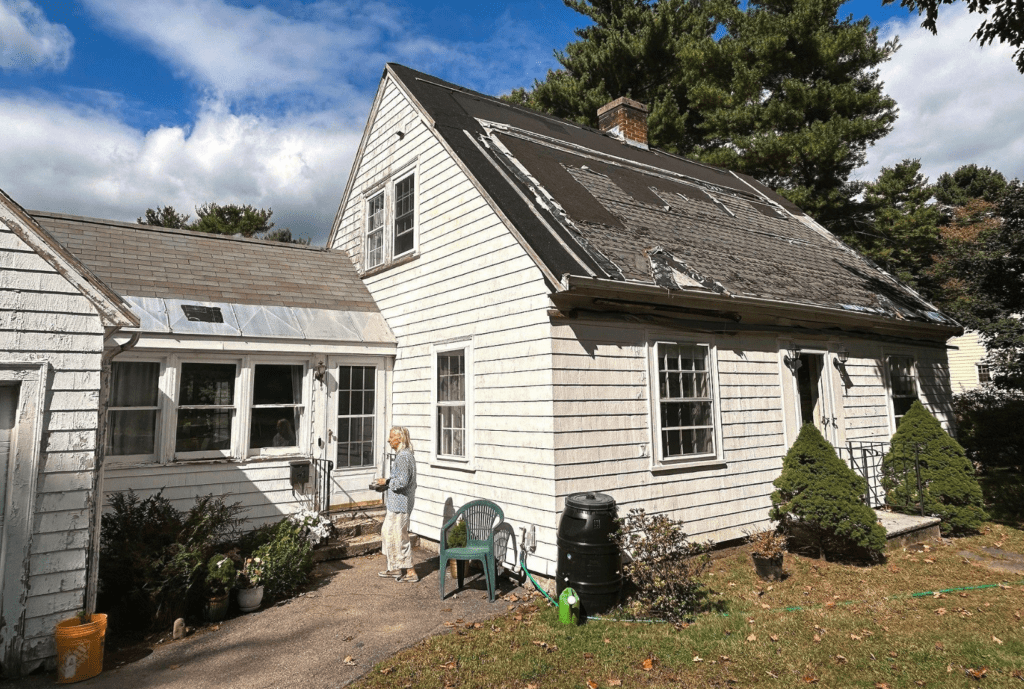
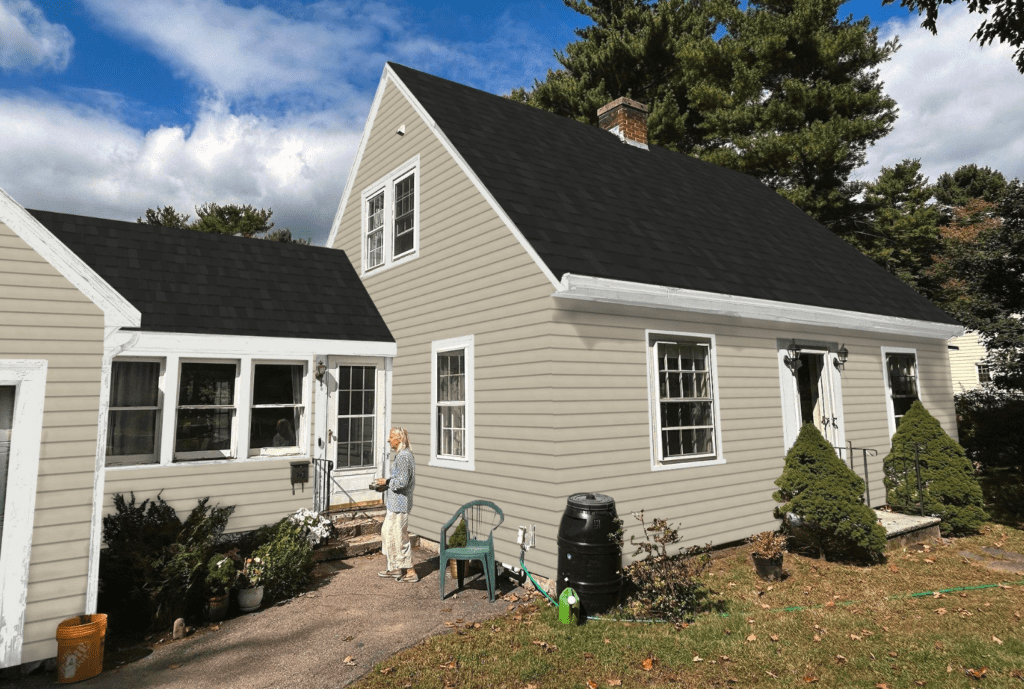
ROOFING VISUALIZER TOOL
See Your Home with a New Roof in Seconds
Help your homeowners visualize new roofing and colors on their own home with Renoworks’ AI technology in seconds.
- Easy-to-use interface designed for contractors and professionals working with homeowners.
Black Shingle
When think of black shingles, elegance and sophistication immediately come to mind. There’s something timeless about a black roof that sets it apart from other colors. It’s not just the classic appeal; black shingles have practical benefits too.
Visual Impact
Black shingles create a striking contrast with most exterior paint colors, enhancing curb appeal instantly. Whether your home is painted white, gray or even bold hues like blue or red, a black shingled roof can tie everything together seamlessly. In my neighborhood alone, homes with dark roofs stand out for their sleek look and modern vibe.
Energy Efficiency
Contrary to popular belief that darker colors absorb more heat (which they do), advanced roofing technologies now mitigate this effect significantly in black shingles. Modern manufacturing incorporates reflective granules into the material composition which helps reduce heat absorption by reflecting sunlight away from the house rather than letting it seep inside.
These innovations make them surprisingly energy-efficient choices despite their color intensity—so if you’ve been hesitant because you’re worried about extra cooling costs during summer months rest easy knowing there are solutions available today tailored specifically toward improving overall performance while still achieving aesthetic goals desired through these beautifully designed materials!
Brown Shingle
Brown shingles offer a unique blend of warmth and elegance to any home. They create an inviting atmosphere, making them popular for many homeowners looking to enhance their curb appeal.
Aesthetic Appeal
The natural tones in brown shingles can complement various exterior colors, including beige, cream, and earthy greens. This versatility ensures that your roof harmonizes with the overall look of your house. For example:
Traditional Homes: Brown shingles provide a classic look.
Modern Designs: Pair well with contemporary styles by adding depth without overpowering sleek lines.
Energy Efficiency
Contrary to what some might think about dark-colored roofs absorbing heat more than lighter ones, modern brown shingles often include reflective granules. These advanced materials help reduce heat absorption from sunlight which keeps interiors cooler during summer months.
Feature | Benefit |
|---|---|
Reflective Granules | Lower indoor temperatures |
Natural Tones | Enhanced aesthetic compatibility |
Durability
Brown shingle roofs are known for their durability due to advancements in manufacturing processes and materials used today. High-quality asphalt or composite brown shingles resist harsh weather conditions like heavy rainstorms or snow loads better than traditional options did decades ago.
Wind Resistance – Handles strong winds effectively.
Water Repellency – Prevents water infiltration issues.
Longevity – Lasts longer thanks primarily due improved composition techniques applied industry-wide nowadays.
Gray Shingle
Gray shingles have this amazing ability to bring a sense of calm and sophistication to any home. When I see gray roofs, they always strike me as both modern and timeless. They offer versatility because they’re neutral but far from boring.
Aesthetic Appeal
The aesthetic appeal of gray shingles is undeniable. They work beautifully with almost every exterior color scheme you can think of—white trim? Perfect match! Brick facade? Absolutely stunning! The subtlety of the gray shingle allows other design elements on your home’s exterior to pop without overwhelming them.
Energy Efficiency
One thing that often gets overlooked about colored roofs like these is their energy efficiency potential. Many people don’t realize that even though darker colors absorb more heat, advances in roofing technology now incorporate reflective granules into the shingles themselves. These reflective granules help bounce back sunlight which keeps your house cooler during those hot summer months.
Aspect | Benefit |
|---|---|
Reflective Granules | Reduces heat absorption |
Neutral Color | Complements various exterior paint schemes |
Durability And Maintenance
Durability’s another strong suit for gray shingles thanks largely due advancements materials used manufacture them today provide resistance against harsh weather conditions ensuring longevity roof itself making investment truly worthwhile also maintenance relatively easy since dirt grime less noticeable compared lighter-colored counterparts
Other Colors
When it comes to choosing a roof color, there are plenty of options beyond the classic black, brown, and gray. Let’s dive into some vibrant choices that can make your home stand out.
Red Roofs
Red roofs bring an eye-catching charm that’s hard to ignore. They’re perfect for homes with brick exteriors or Mediterranean-style architecture. The bold hue adds warmth and personality while offering excellent UV protection due to advanced reflective technology in modern shingles.
Blue Roofs
Blue roofs provide a unique touch of serenity and sophistication. They work exceptionally well with coastal homes or properties near water bodies. Light blue shades reflect more sunlight, keeping interiors cooler during hot summer months.
Green Roofs
Green roofs blend harmoniously with natural surroundings like gardens or wooded areas. Darker green tones offer elegance without overwhelming other design elements on the exterior facade—plus they tend not only absorb heat but also complement eco-friendly initiatives when combined with sustainable materials.
Beige And Tan Roofs
Beige and tan colors create subtle yet stylish appearances suitable for various architectural styles from contemporary designs up through traditional structures alike! These neutral tones often match earthy landscapes beautifully while still maintaining energy efficiency by reflecting solar radiation effectively off their surfaces thanks again largely part innovative technologies incorporated within today’s roofing products themselves!
Incorporating these different hues offers versatility allowing homeowners personalize aesthetics along practical benefits making colored rooftops worth considering next time you’re planning any renovations updates around house too!
Factors to Consider When Choosing Roof Color
Choosing the right roof color can make a big difference in your home’s overall look and feel. It’s not just about aesthetics, though—various factors come into play.
Roof Color
Roof color is more than just picking what looks good. Light-colored roofs like white or light gray reflect sunlight, keeping homes cooler in warm climates. Dark colors absorb heat, which might be beneficial for colder regions as they help with heating costs. Reflective granules on shingles add energy efficiency regardless of their base shade.
Architectural Style
Your home’s architectural style should influence your choice of roof color. For instance:
Traditional Homes: Earth tones like brown and green complement rustic designs.
Modern Homes: Bold shades such as black or dark blue highlight contemporary lines.
Victorian Houses: Vibrant reds and deep greens enhance ornate details.
Matching the roof to existing design elements creates harmony across exteriors while boosting curb appeal.
Hot Climates: Lighter hues keep interiors cool by reflecting solar radiation.
Cold Climates: Darker shades provide warmth through increased heat absorption during sunny winter days.
Coastal Areas: Colors resistant to fading from saltwater exposure ensure long-lasting vibrancy; think slate blues or sandy tans fitting naturally within beachfront settings.
- Urban Environments: Neutral grays reduce glare amidst concrete jungles yet still offer modern sophistication suitable amongst high-rise surroundings.
Roof Shingle Material and Color
Choosing the right material and color for roof shingles can make a significant difference in your home’s appearance, energy efficiency, and durability. It’s not just about aesthetics; it’s also about how well your roof performs under different weather conditions.
Asphalt Shingle
Asphalt shingles are incredibly popular due to their affordability, versatility, and ease of installation. I’ve seen countless homes with these durable materials that come in almost any color you can imagine—black, brown, gray—you name it! They’re especially great if you’re looking for something cost-effective without compromising on quality.
For those living in warmer climates where reflecting sunlight is crucial to keep cooling costs down (think southern states like Florida or Texas), lighter-colored asphalt shingles such as beige or light gray work wonders by bouncing off most of the sun’s rays. On the other hand (for my friends up north who deal with harsher winters), darker shades like deep black or dark green help absorb heat from whatever little sunlight there is during chilly days.
But don’t think practicality means boring—I’ve noticed more homeowners experimenting with vibrant colors too! Blues add an unexpected pop while reds create a striking contrast against lush greenery surrounding suburban houses. With so many options available now thanks largely because manufacturers realized we all want our roofs both functional AND fabulous!
Designer Shingle
Designer shingles offer another level entirely when compared to traditional ones—they’re essentially high-end versions crafted meticulously using superior-quality materials designed specifically enhance curb appeal dramatically increasing property value along way!
I remember driving past this stunning Victorian house adorned beautifully intricate designer slate-like patterned shingled rooftop—it looked straight out fairy tale book cover had me swooning instantly dreaming someday having similar showstopper atop own abode!!
Combining Roof Color with Exterior Elements
Choosing the right roof color can completely transform your home’s look. But it’s not just about picking a pretty shade; you’ve got to think about how it plays with other exterior elements.
Color Combination
Pairing roof colors with exterior elements requires careful consideration of balance and harmony. I always recommend starting by looking at your house’s fixed features like brick, stone, or siding. For example:
Red Brick Houses: Complement red bricks with dark gray or black shingles for an elegant contrast.
Stone Exteriors: Earth-toned roofs (browns and greens) blend well if you’ve got natural stone walls.
Wooden Siding: Warm hues on wooden exteriors match beautifully with brown or reddish-brown shingles.
In my experience, matching isn’t as crucial as complementing – contrasting shades often bring out the best in both materials without clashing.
Siding Color
Your home’s siding is another critical factor when choosing a roof color. Here are some guidelines based on common siding options:
White Siding:
Almost any roofing hue works here! Darker roofs (black/gray) create classic looks while bold choices like blue add character.
Beige/Tan Siding:
Stick to warm tones—think browns and reds—to keep things cohesive yet inviting.
Gray/Silver Siding:
Cool-colored sidings benefit from blues/grays that enhance modern aesthetics but avoid too much monotony by adding subtle contrasts within those palettes.
Remember this tip I’ve learned over time: Always grab samples before making final decisions—it makes visualizing combinations easier than imagining them abstractly!
Practical Tips for Selecting Roof Color
Choosing the right roof color can make a huge difference in your home’s curb appeal. Let’s dive into some practical tips to help you select the perfect shade.
Best Roof Color
Finding the best roof color isn’t just about aesthetics; it’s also about functionality. For homes in warmer climates, lighter colors like white or light gray reflect more sunlight and keep interiors cooler. In colder regions, darker shades such as black or dark brown absorb heat better and help maintain warmth inside.
Consider fixed elements on your house too—like brick, stone, or siding—when picking a color. If you’ve got red brick walls, earth tones like tan or brown might work wonders. Stone exteriors pair beautifully with grays while wooden sidings often look great with greenish hues that blend naturally with surroundings.
Trends and Innovations in Roof Colors
Roof colors have come a long way from the traditional blacks, grays, and browns. Today’s homeowners are getting bolder with their choices, experimenting with hues that add personality to their homes while improving energy efficiency.
Cool Roof
Cool roofs are gaining popularity for good reason. These roofs reflect more sunlight than standard ones which keeps your home cooler during those hot summer months. If you live in a warmer climate like Arizona or Florida you’ll appreciate how cool roofs can lower your cooling costs by up to 15%. They’re available in various shades including light blues greens and even whites making it easier than ever to find something that complements your home’s exterior.
Benefits:
Energy Efficiency: Reflects sunlight reduces heat absorption
Cost Savings: Lowers air conditioning expenses
Environmental Impact: Decreases urban heat islands
I remember when my neighbor switched to a cool roof last year; not only did his electric bill drop significantly but his house also stood out beautifully among others on our street!
New Roof Trends
New trends aren’t just about color anymore though that’s still important! Homeowners now want texture pattern and sustainability too:
Bold Colors (e.g., deep reds vibrant blues): Making statements adding curb appeal.
Mixed Materials (e.g., metal wood composite shingles): Offering unique looks combining durability styles.
Designer Shingles (varied shapes patterns): Adding dimension character creating custom appearances without high costs of specialty materials.
Just recently I saw this amazing mix-and-match design using dark green asphalt tiles paired seamlessly against sleek black solar panels—it was both eco-friendly chic proving functionality doesn’t mean compromising style at all!
Conclusion
Choosing the right colored roof is more than just an aesthetic decision; it’s about enhancing your home’s value and functionality. From affordable asphalt shingles to energy-efficient cool roofs, there are options for every need and budget. Bold colors and mixed materials can add unique flair while also considering climate impact ensures long-term benefits. Trends in roofing continue to evolve offering homeowners endless possibilities for creativity sustainability and cost savings. So when it’s time to update or install a new roof remember that color plays a crucial role in creating the perfect harmony between beauty efficiency and durability.
Frequently Asked Questions
Why are asphalt shingles recommended for roofing?
Asphalt shingles are recommended because they offer affordability, versatility in styles and colors, and durability. They also provide good weather resistance.
How can I choose the right roof color to match my home’s exterior?
Select a roof color that complements fixed elements like brick, stone, or siding. Consider how the shade harmonizes with these features to enhance your home’s overall appearance.
What factors should influence my choice of roof color based on climate?
In warmer climates, lighter shades reflect heat and keep homes cooler. In colder areas, darker hues absorb more sunlight to help retain warmth inside the house.
Are there any trends in roofing materials currently popular among homeowners?
Yes! Trends include bold colors, mixed materials like combining different shingle types or textures, designer shingles with unique patterns and designs focusing on both aesthetics and sustainability.
What is a cool roof and why might it be beneficial for me?
A cool roof uses reflective materials that reduce heat absorption. It enhances energy efficiency by keeping buildings cooler during hot seasons which leads to cost savings on air conditioning bills.


ROOFING VISUALIZER TOOL
See Your Home with a New Roof in Seconds
Help your homeowners visualize new roofing and colors on their own home with Renoworks’ AI technology in seconds.
- Easy-to-use interface designed for contractors and professionals working with homeowners.
Related Articles
Continue exploring this topic with these related articles, or read one of our case studies to see how visualization has helped remodelers save time and increase their profits.


